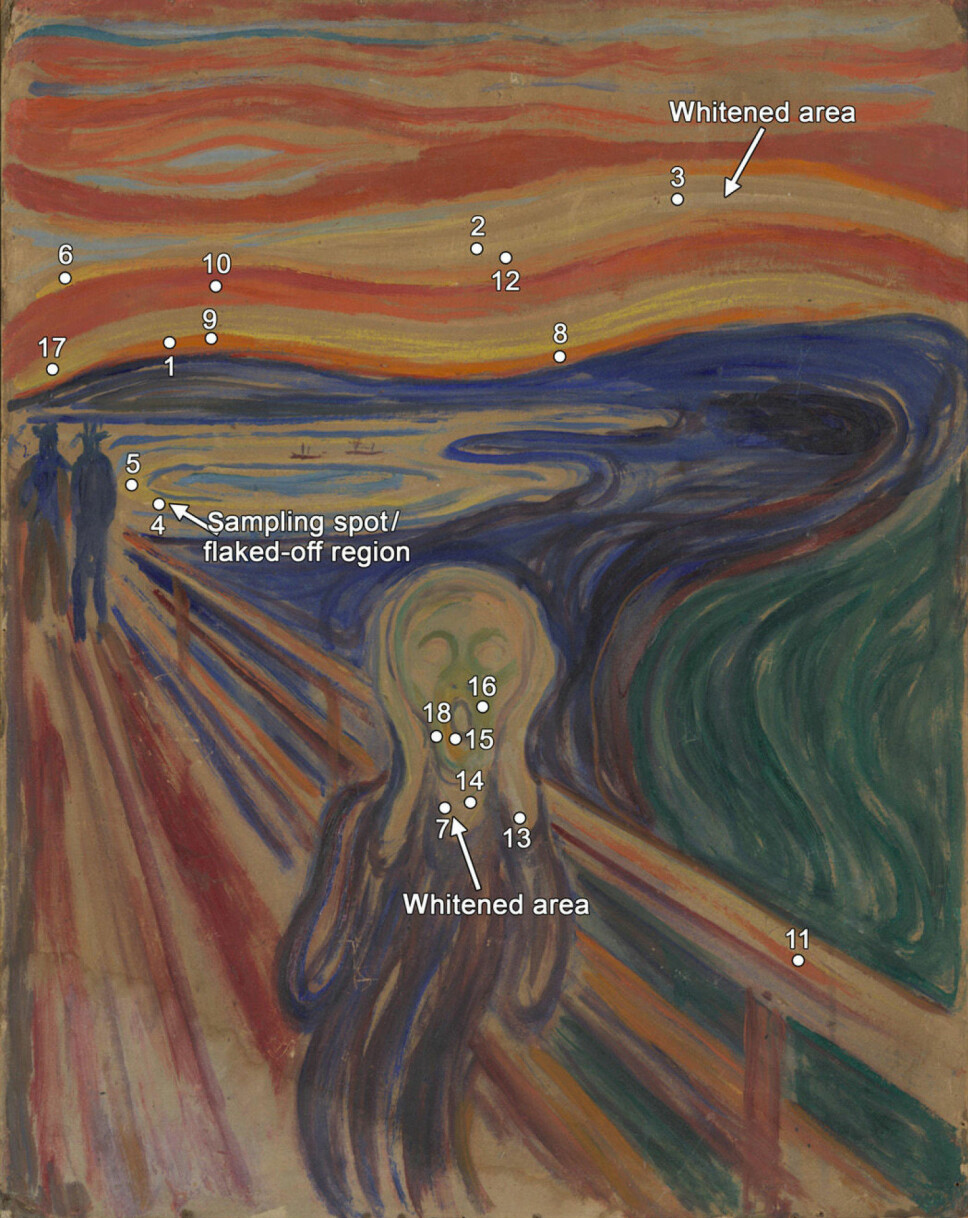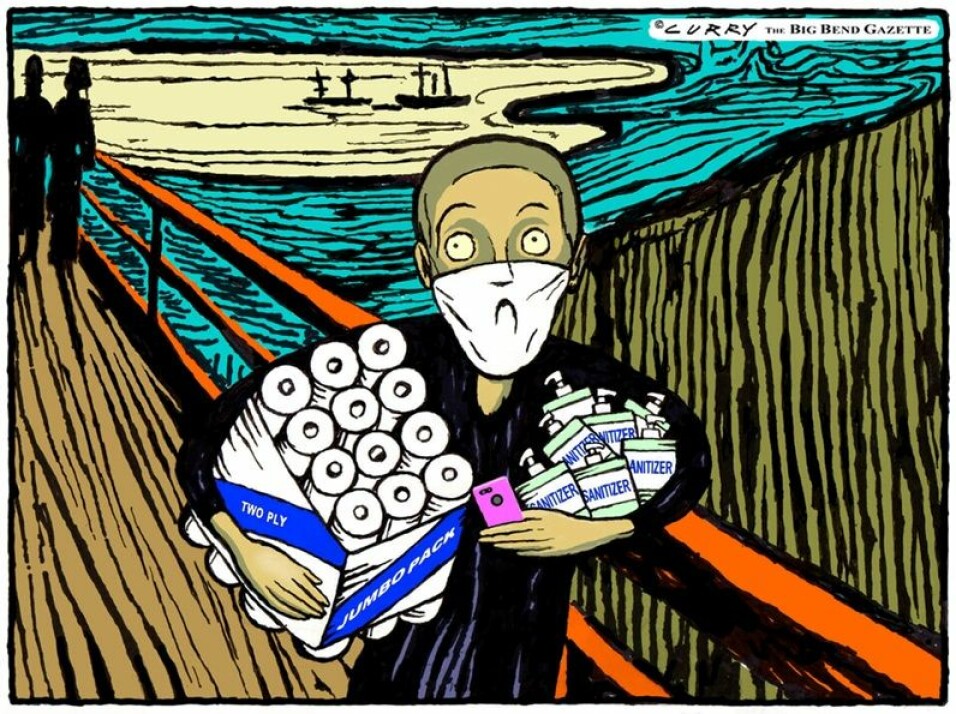
Scientists have determined what damaged Edvard Munch's "The Scream"
Why has the lively yellow paint on Edvard Munch's 1910 painting The Scream faded and flaked off? A new study lays the blame on moisture. Chemists from several countries have conducted experiments that have helped them come up with the answer.
The iconic painting The Scream by Edvard Munch has become the ultimate symbol of anxiety and psychological despair. It is also one of the most famous paintings from the modernism movement.
But The Scream has rarely been exhibited since 2006.
The reason is not only that it has been stolen — twice. The first theft occurred during the 1994 opening ceremony for the Winter Olympics at Lillehammer, and it was only recovered three months later. Then it was stolen again in 2004, and was only recovered two years later.
No, another reason is that the paint's vivid yellow pigments have faded.
Volatile yellow
The original yellow brush strokes in the sky in the painting have faded to muted white, or off-white. This also applies to the neck portion of the central screaming figure.
The cadmium sulphide yellow colour is fragile. The thick strips of the sea are also flaking off.
To prevent the painting from decaying even more, the Munch Museum has kept the painting in storage, with muted light, a constant temperature of about 18 degrees C, and about 50 per cent humidity.
Now a thorough chemical analysis of the painting shows that moisture is the main cause of the deterioration. The study was recently published in the journal Science Advances.
Moisture is the main problem
In collaboration with the Munch Museum, researchers from Italy, Belgium, France, Germany and the United States analysed microscopic flakes of the paint from The Scream.
They have discovered new details as to how the colour pigments in the cadmium sulphide have weathered and degraded.
First, they found that the yellow colour in "Scream" contained cadmium sulphate, a degradation product of cadmium sulphite. These studies were carefully done on tiny samples of the paint, including by using micro-X-rays at the European Synchrotron, in Grenoble, France.
In order to get to the bottom of the cause of the damage, researchers have tested new paints with similar chemical content.
They used yellow pigment powders of cadmium and cadmium from a yellow tube of oil paint that Munch owned.
They then subjected the paint to artificial ageing by exposing it to various physical stresses.
The researchers also found cadmium sulphate in the artificially aged paint that was exposed to at least 95 per cent moisture, both in the light and dark.

Three causes behind the deterioration
Similar samples exposed to light in 45 per cent humidity showed no signs of decay.
“Light plays a minor role,” chemist Letizia Monico told Science News. She is a researcher at the University of Pergula, Italy, and led the study.
This suggests that moisture has been the main culprit behind the ageing of The Scream, and that the painting should be stored at humidity levels of 45 per cent or less.
Munch's experimentation with different materials for his colours also made parts of the painting less durable.
And when the painting was recovered after being stolen in 2004, it had a shield in the left corner that couldn't be removed.
Thus, there are three reasons for the deterioration of The Scream: the theft, the pigments in the painting’s colours and poor storage conditions.
You can read more about The Scream on the Munch Museum's website.

Can also be relevant for Matisse and van Gogh paintings
The findings will help the conservators return the painting to its original expression, and make it ready for exhibition again.
"The study has provided new knowledge that can lead to practical adaptations in the Munch Museum's conservation," says Irina C. A. Sandu, a conservation researcher at the Munch Museum.
The new Munch Museum is scheduled to open in 2020. The museum will now look at how the study will affect today's storage of the paintings.
“We also have to consider how other materials in the collection will respond to any adjustments,” says Eva Storevik Tveit, painting conservator at the Munch Museum, in a press release.
This new knowledge can also provide valuable information on how to conserve paintings by Munch's contemporaries, the researchers say.
These include Matisse and van Gogh, who also painted using yellow paint based on cadmium sulphide pigments.
But each painting is unique, with a complicated chemical landscape. Therefore, each conservation strategy must be crafted individually, Monico, the Italian chemist, said.
Multiple versions of The Scream
Edvard Munch made several versions of The Scream. The two most famous are paintings from 1893 and 1910. He also created two pastel paintings and several lithographs, as well as some drawings and sketches.
Each version is unique. Munch was obviously experimenting to find exactly the right colours to convey his personal experience.
He blended various materials such as oil, pastel and tempera to produce “colours that were screaming” as much as possible. Unfortunately, the mixes present a challenge for long-term preservation of Munch's artwork.
(Tempera is usually a mixture of oil and water, mixed with an emulsion. Egg tempera is most common.)
Translated by Nancy Bazilchuk
Reference:
L. Monico et al.: Probing the chemistry of CdS paints in The Scream by in situ noninvasive spectroscopies and synchrotron radiation X-ray techniques. Science Advances, May 15, 2020. doi: 10.1126 / sciadv.aay3514.
———































